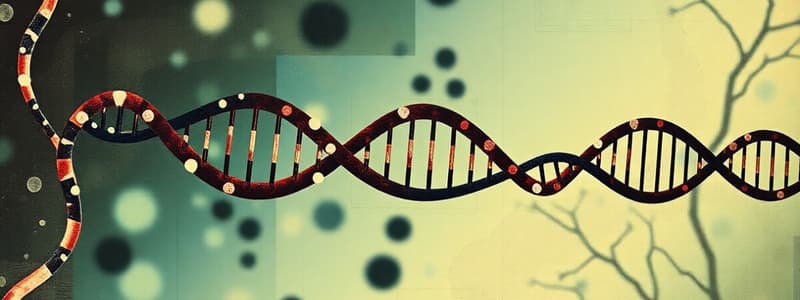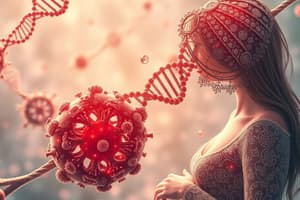Podcast
Questions and Answers
What is the primary function of DNA replication?
What is the primary function of DNA replication?
- To transmit genetic information from cell to cell (correct)
- To break down nucleotides for energy
- To synthesize proteins from the DNA template
- To create mutations in the genetic material
During which phase of the cell cycle does DNA replication occur in eukaryotes?
During which phase of the cell cycle does DNA replication occur in eukaryotes?
- G1 phase
- M phase
- S phase (correct)
- G2 phase
Which model of DNA replication proposes that both parental strands are conserved after replication?
Which model of DNA replication proposes that both parental strands are conserved after replication?
- Hybrid model
- Dispersive model
- Semiconservative model
- Conservative model (correct)
What is the replication rate of nucleotides per minute in humans?
What is the replication rate of nucleotides per minute in humans?
What rule dictates the pairing of nucleotides during DNA replication?
What rule dictates the pairing of nucleotides during DNA replication?
Which statement best describes the semiconservative model of DNA replication?
Which statement best describes the semiconservative model of DNA replication?
Why is extreme accuracy crucial during DNA replication?
Why is extreme accuracy crucial during DNA replication?
Which of the following best describes the role of individual nucleotides during DNA replication?
Which of the following best describes the role of individual nucleotides during DNA replication?
What is the role of helicase in DNA replication?
What is the role of helicase in DNA replication?
In which direction is new DNA synthesized during replication?
In which direction is new DNA synthesized during replication?
Which proteins are responsible for preventing premature reannealing of DNA during replication?
Which proteins are responsible for preventing premature reannealing of DNA during replication?
What initiates the synthesis of RNA primers in DNA replication?
What initiates the synthesis of RNA primers in DNA replication?
How does the lagging strand differ from the leading strand during DNA replication?
How does the lagging strand differ from the leading strand during DNA replication?
What is the function of topoisomerase during DNA replication?
What is the function of topoisomerase during DNA replication?
What is formed when DNA replication is terminated?
What is formed when DNA replication is terminated?
Which of the following statements is true regarding the origin of replication?
Which of the following statements is true regarding the origin of replication?
What function does the enzyme Ligase serve in DNA replication?
What function does the enzyme Ligase serve in DNA replication?
Which property is true of all DNA polymerases?
Which property is true of all DNA polymerases?
What is the primary role of DNA Pol I in bacteria?
What is the primary role of DNA Pol I in bacteria?
What mechanism allows DNA polymerases to correct errors during DNA synthesis?
What mechanism allows DNA polymerases to correct errors during DNA synthesis?
How does telomerase help in eukaryotic DNA replication?
How does telomerase help in eukaryotic DNA replication?
Which statement best describes the error rate of DNA synthesis after proofreading?
Which statement best describes the error rate of DNA synthesis after proofreading?
What occurs at the termination sites during prokaryotic DNA replication?
What occurs at the termination sites during prokaryotic DNA replication?
What is the function of replication bubbles in DNA replication?
What is the function of replication bubbles in DNA replication?
Flashcards
DNA Replication
DNA Replication
The process of copying the entire genome before cell division, ensuring genetic information is passed on to offspring.
S Phase
S Phase
The phase of the cell cycle where DNA replication occurs.
Origins of Replication
Origins of Replication
The specific sites on DNA where replication begins.
Initiator Proteins
Initiator Proteins
Signup and view all the flashcards
Helicase
Helicase
Signup and view all the flashcards
Single-Strand Binding Proteins
Single-Strand Binding Proteins
Signup and view all the flashcards
Topoisomerase
Topoisomerase
Signup and view all the flashcards
RNA Primers
RNA Primers
Signup and view all the flashcards
Primase
Primase
Signup and view all the flashcards
DNA Polymerase
DNA Polymerase
Signup and view all the flashcards
Leading Strand Synthesis
Leading Strand Synthesis
Signup and view all the flashcards
Lagging Strand Synthesis
Lagging Strand Synthesis
Signup and view all the flashcards
Okazaki Fragments
Okazaki Fragments
Signup and view all the flashcards
DNA Ligase
DNA Ligase
Signup and view all the flashcards
Termination Sites
Termination Sites
Signup and view all the flashcards
Telomerase
Telomerase
Signup and view all the flashcards
Telomeres
Telomeres
Signup and view all the flashcards
Proofreading
Proofreading
Signup and view all the flashcards
3'-5' Exonuclease Activity
3'-5' Exonuclease Activity
Signup and view all the flashcards
Replication Bubbles
Replication Bubbles
Signup and view all the flashcards
5'-3' Direction
5'-3' Direction
Signup and view all the flashcards
Template DNA
Template DNA
Signup and view all the flashcards
DNA Polymerase Limitations
DNA Polymerase Limitations
Signup and view all the flashcards
Replication Rate
Replication Rate
Signup and view all the flashcards
Replication Fidelity
Replication Fidelity
Signup and view all the flashcards
Study Notes
DNA Replication
- The process of copying the entire genome prior to cell division
- Ensures the integrity of the genome across generations
- Occurs during the S phase of the cell cycle in eukaryotes
- Slower replication rate in eukaryotes results in higher fidelity/accuracy
- Humans add 3000 nucleotides per minute; bacteria add 30,000 per minute
- Relies on the complementarity of DNA strands, following the AT/GC rule
Mechanism of DNA Replication
-
Initiation:
- Initiator proteins bind to specific base sequences on DNA called "sites of origin"
- Prokaryotes have a single origin site (e.g., oriC in E. coli)
- Eukaryotes have multiple sites of origin (e.g., ARS sequences in yeast)
- Helicase unwinds and separates the double-stranded DNA, creating a replication fork
- Single-Strand Binding Proteins stabilize the separated strands
- Topoisomerase relieves stress on the DNA molecule during separation
-
Elongation:
- Synthesis always occurs in the 5´-3´ direction
- RNA primers are required to initiate nucleotide addition
- Primase synthesizes the RNA primer
- DNA polymerase adds nucleotides to the 3´ end of the primer
- Leading strand is synthesized continuously
- Lagging strand is synthesized discontinuously in short segments called Okazaki fragments
- Okazaki fragments are ~1000-2000 bp in prokaryotes and ~100-200 bp in eukaryotes
- DNA ligase joins the Okazaki fragments together
-
Termination:
- In prokaryotes, replication forks reach specific "termination sites"
- In eukaryotes, telomerase solves the problem of gaps left after RNA primer removal at the 5´ end of the lagging strand
Proteins Involved in DNA Replication
- DNA polymerase: Adds nucleotides to the growing DNA strand. Proofreads for errors.
- Helicase: Unwinds the DNA double helix
- Topoisomerase: Relieves torsional stress from unwinding
- RNA primase: Synthesizes RNA primers
- Single-strand binding proteins: Prevents reannealing of separated DNA strands
- DNA ligase: Joins Okazaki fragments on the lagging strand
Characteristics of DNA Polymerase
- Synthesizes DNA in only one direction (5´-3´)
- Requires a pre-existing double-stranded DNA to begin synthesis
- Cannot initiate DNA synthesis from scratch
Proofreading and Error Correction
- DNA polymerase initially makes errors at a rate of 1 in 10,000 base pairings
- Proofreading enzymes correct these errors
- DNA polymerases possess 3´-5´ exonuclease activity, allowing them to remove mismatched nucleotides
- This process improves accuracy to 1 in 1 billion base pairing errors
Replication Bubbles
- Replication occurs in both directions along the DNA
- Both strands are replicated simultaneously
- This process generates replication bubbles
Telomeres
- Telomerase extends the lagging strand's 5´ end, preventing degradation
- This solves the problem of gaps left after RNA primer removal
- Essential in eukaryotes for maintaining chromosome stability
Studying That Suits You
Use AI to generate personalized quizzes and flashcards to suit your learning preferences.




